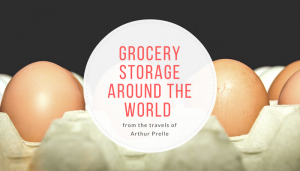 If you were born and raised in the United States, you’re used to going into the refrigerated section of the grocery store to find your eggs, and you purchase your milk in a plastic jug or carton. Upon leaving the US, though, you’ll quickly realize that we’re kind of an anomaly. Most non-US nations store eggs at room temperature on shelves next to crackers and other pantry goods.
If you were born and raised in the United States, you’re used to going into the refrigerated section of the grocery store to find your eggs, and you purchase your milk in a plastic jug or carton. Upon leaving the US, though, you’ll quickly realize that we’re kind of an anomaly. Most non-US nations store eggs at room temperature on shelves next to crackers and other pantry goods.
The “refrigerated eggs” club includes the United States, most Scandinavian nations, Switzerland, and Japan, where most of the rest of Europe, Africa, and Asia leaves eggs at room temperature among other shelf items. What causes the difference in egg storage? It’s a little science and a little culture.
The USDA-approved method for cleaning eggs in the US involves a hot water and shampoo shower very shortly after the eggs are harvested. Japan and Scandinavia follow similar methods. While this method gets the eggs “clean,” it leaves them vulnerable, since the bath removes a thin natural film that keeps unwanted bacteria and viruses out and oxygen and water in. When “washed,” then, eggs reveal hairline cracks and openings which expose them to perils of the outside world. To counteract this exposure, egg manufacturers then spray the eggs with an oil to replace the washed-away film and keep them refrigerated at a temperature low enough to neutralize any bacteria.
Where the US washes the eggs and refrigerates them in order to ward of salmonella, most European manufacturers vaccinate their hens against becoming infected with salmonella in the first place, which does away with the need for refrigeration. Thus, many of our European counterparts don’t put their eggs in coolers. That doesn’t explain why most developing nations don’t follow suit, though.
Part of US culture, now, is that we’re clean freaks. We sanitize everything and wrap our food in unnecessary layers of packaging for fear of microorganisms and germs. To that end, we view chickens as inherently dirty birds and mere vesicles for salmonella. Children are admonished not to eat raw cookie or brownie dough for fear that raw eggs could transmit salmonella before it’s cooked at high enough temperatures to kill the bacteria.
Many developing nations don’t experience the same level of disgust at natural dirt. Eggs are sometimes dirty with mud, chicken droppings, and other substances found in a chicken coop, and to people in developing nations, that’s just how eggs are. Washing eggs as vigorously as the US does simply isn’t a necessity to their culture. Additionally, it’s expensive to run refrigerators, and some economies can’t support the additional room eggs would take up in cold spaces.
Milk is another silly area where the US and some other nations differ. Canada, Russia, and Argentina purchase milk in bags, while most of the rest of the world stores and sells milk in jugs or bottles. At least for Canada, the reason for pouches is pretty simple. It wasn’t the ease of transport, nor was it the efficiency of storage. Rather, it was the metric system. A gallon of milk doesn’t easily convert to metric liters. The DuPonts, rather than developing a whole new jug, decided to package milk in bags for the ease of changing sizes and measurements. At the same time, milk pouches sized for kids’ lunches grew in popularity in Canada and South America.
Standard US packaging and storage isn’t so standard throughout the world for all sorts of reasons, and in travels, it’s fun to observe and investigate the differences in basic foodstuffs in grocery stores.